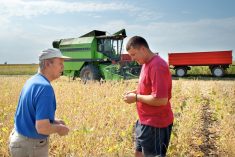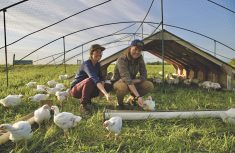Their eyes are full of wonder, surprise and amazement. Miniature skaters glide over the ice, a parachute goes up and down, mother bear and her cubs climb trees and Grandma bakes bread. Behind the displays antique motors whir, cables move and wooden rods push and pull. In the 1940s, the display attracted Christmas crowds to the windows of the T. Eaton store in downtown Winnipeg. It was packed away for years and then donated to the Western Development Museum in Saskatoon. Volunteers patiently restored it.
Today hundreds of Grade 3 children are visiting the museum which features a typical 1910 Prairie town main street. The street is transformed by sparkling Christmas trees for the season. Small well-scrubbed faces are entranced. They move from the Eaton display to the stores. Each child has $1 to shop for Christmas gifts. The children buy licorice and candies at the old-time price of one cent each. I am assigned the role of storekeeper. I explain how people shopped. The storekeeper would stand behind his counter and write orders. He would then collect the items, wrap up purchases in brown paper tied with string, and ring up the bill in a large cash register.
Read Also

Employment Agreements Can Help Protect Your Farm
Entering into employment agreements with each of your farm employees should be at the top of every farm’s “to do” list, but caution must be exercised.
I describe how mothers made clothes out of flour sacks. A child asks me if I minded wearing homemade clothes. In her imagination I had lived the experience myself.
After the school buses depart, the volunteers gather for coffee and cake. I strike up a conversation with Art. Before retirement he worked at the airport keeping the runway lights and navigation equipment in operation. He told me how he started his working career installing rural electrification. When electricity spread across Saskatchewan in the late 1940s and early 1950s, installation crews went from farm to farm. They boarded with the farmers. “A different bed every night,” he chuckled.
Art recalled a farm near Hafford, Sask. The crew encouraged the farmer and his family to go to town and return at dusk. As the owners turned into the driveway, Art switched on the power. The house, barn, shed and yard lit up all at once. The family, who had milked cows and done homework by coal oil lamps, was amazed by the beauty of light.
Art continued: “Every day I am grateful to be here.” He told me how he had a triple bypass operation on his heart. A decade later the outlook was not good. His only chance was a heart transplant. As the weeks went by, he began to lose hope. One Friday night as he lay in a hospital bed, the phone rang. An airplane was waiting at the Saskatoon airport. He would be leaving in 20 minutes for Edmonton where a donor’s heart was waiting. Art said, “I am a new man. I am walking around with another person’s heart. I am making the most of the new opportunities life has given me.”
When I go to church on Christmas Eve, I will think about the wonder in the eyes of the children, and about Art and the miracle of modern medicine which gave him new life. When the story from Matthew about the wise men following a star to Bethlehem is read, I will think about hundreds of Prairie farms getting electricity for the first time. Christmas is about real people and real things made magic by a God who gives life and light.
SuggestedScripture:Isaiah60,St.Matthew2:1-12
Rod Andrews is a retired Anglican bishop. He lives in Saskatoon.














